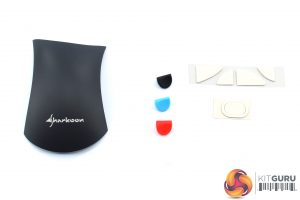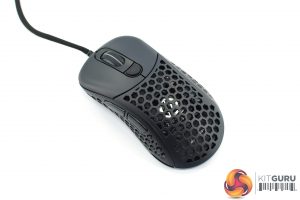The Sharkoon Light2 200 ships in a compact black box, with a large image of the mouse itself visible on the front alongside three key features Sharkoon has highlighted – the RGB lighting, PMW 3389 sensor, and the 62g total weight.
On the back of the box, we find multi-lingual text pointing out a similar selection of features.
Inside, before we get to the mouse itself, Sharkoon has also included some extras in the box. These include a little manual, but more interesting is the replacement top shell for the mouse, as well as some replaceable DPI button covers – more on those below. Finally, an extra set of PTFE mouse feet are also included.
Getting our first proper look at the Light2 200, as mentioned on the first page it is clear Sharkoon is using the Zowie EC shape here – a well-regarded, ergonomic shape designed exclusively for right-handers. The obvious difference is that Sharkoon is trying to keep weight to a minimum with the Light2 200, so the shell is absolutely covered in small hexagonal holes.
Just to provide a bit more context here, Sharkoon's official measurements for the mouse are as follows: 120x66x42mm (L x W x H). This means the Light2 200 is closer to the EC2 in size, as the EC1 is 8mm longer and also 3mm wider. Overall, I'd class the Light2 200 as a medium-sized ergonomic mouse.
On the left-hand side of the mouse, we can see more holes in the shell, as well as two side buttons. There's no buttons on the right-hand side – just more holes.
Interestingly, one thing you can also tell from the images above is Sharkoon has used a slightly different plastic for the sides of the mouse compared to the top shell and buttons. The top is slightly smoother and also more of a dark grey colour to my eye, while the sides look slightly darker and also a bit more textured. It's not something that really bothers me, just something to note.
At the front of the mouse, we get a look at the primary buttons which have slight comfort grooves, as well as the rubber scroll wheel. Behind this sits a single DPI button.
As for the cable, Sharkoon calls this ‘an ultra-flexible cable' which is covered in a black braid, and it measures 1.8m long.
Flipping the mouse over, we can again see lots of hexagonal holes cut into the bottom shell. Four small PTFE mouse feet are positioned in each corner, with another oval-shaped foot around the sensor lens. As shown above, a set of spare feet are included in the box.
There's also some customisable elements to the design of the Light2 200. First is the top shell, which is held in place with a set of clips and two magnets. Simply lift from the bottom end of the shell to unhook it from the mouse, and then you can use either the solid shell or the pre-installed ‘holey' one. On my scale, the solid shell weighs 7g and the holey one weighs 4g, so it's not a big difference either way.
Additionally, the rubber DPI button is also removable – one comes pre-installed, and there's three in the box. Simply prise it out with your finger, and you can see each rubber piece simply slots into two small holes in the shell.
This isn't just for aesthetics, though, as you get a choice of two low-profile buttons and two high-profile ones – the blue is low-profile, the red is high-profile, and then one of each in black. This is another good addition from Sharkoon which just gives the end user a bit more choice here.
Disassembling the mouse, we can get a look at the buttons used. The primary buttons are Omron D2FC-F-7N(20M) which are widely used across the industry. We can also see the use of an F-Switch brown encoder, while the scroll wheel click uses a Huano green switch.
In the middle of the PCB, there's also a small piece of plastic, with the Sharkoon Light2 logo stuck on via adhesive. I asked Sharkoon about this and they said it is for aesthetic reasons, but also to provide some protection to the PCB (it sits directly over the sensor) should you spill a drink on the mouse etc.
That piece can be removed with two small screws, and then we can also get a look at the PixArt PMW 3389 sensor used with this mouse.
 KitGuru KitGuru.net – Tech News | Hardware News | Hardware Reviews | IOS | Mobile | Gaming | Graphics Cards
KitGuru KitGuru.net – Tech News | Hardware News | Hardware Reviews | IOS | Mobile | Gaming | Graphics Cards
























